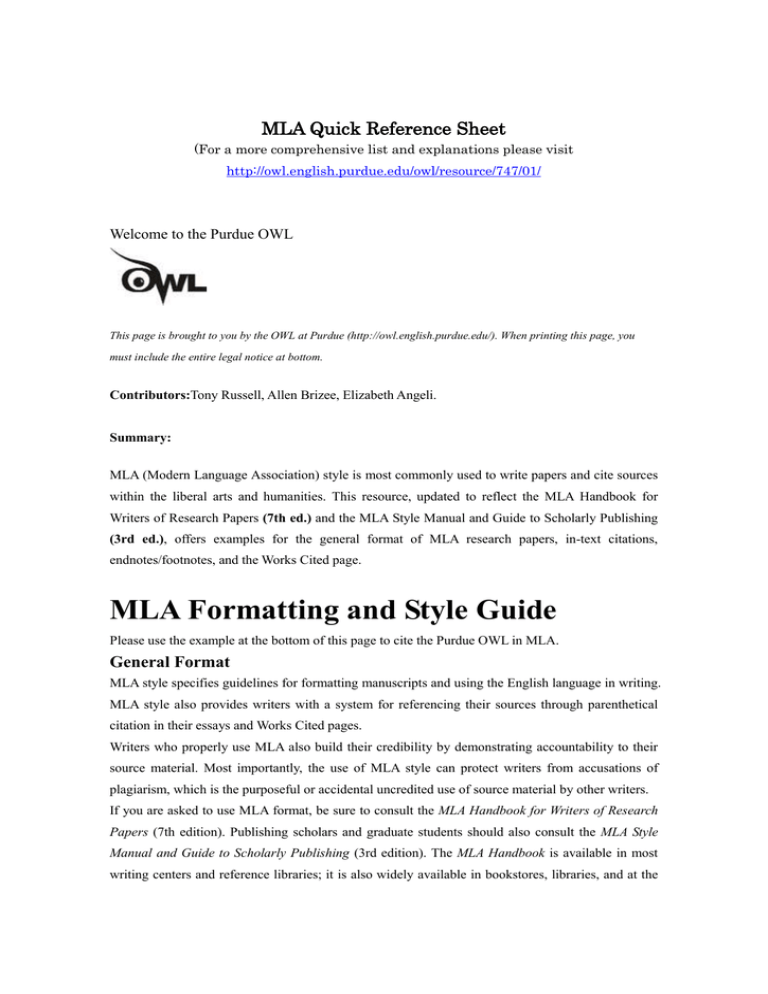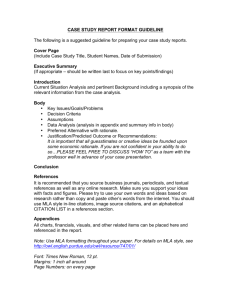
MLA Quick Reference Sheet
(For a more comprehensive list and explanations please visit
http://owl.english.purdue.edu/owl/resource/747/01/
Welcome to the Purdue OWL
This page is brought to you by the OWL at Purdue (http://owl.english.purdue.edu/). When printing this page, you
must include the entire legal notice at bottom.
Contributors:Tony Russell, Allen Brizee, Elizabeth Angeli.
Summary:
MLA (Modern Language Association) style is most commonly used to write papers and cite sources
within the liberal arts and humanities. This resource, updated to reflect the MLA Handbook for
Writers of Research Papers (7th ed.) and the MLA Style Manual and Guide to Scholarly Publishing
(3rd ed.), offers examples for the general format of MLA research papers, in-text citations,
endnotes/footnotes, and the Works Cited page.
MLA Formatting and Style Guide
Please use the example at the bottom of this page to cite the Purdue OWL in MLA.
General Format
MLA style specifies guidelines for formatting manuscripts and using the English language in writing.
MLA style also provides writers with a system for referencing their sources through parenthetical
citation in their essays and Works Cited pages.
Writers who properly use MLA also build their credibility by demonstrating accountability to their
source material. Most importantly, the use of MLA style can protect writers from accusations of
plagiarism, which is the purposeful or accidental uncredited use of source material by other writers.
If you are asked to use MLA format, be sure to consult the MLA Handbook for Writers of Research
Papers (7th edition). Publishing scholars and graduate students should also consult the MLA Style
Manual and Guide to Scholarly Publishing (3rd edition). The MLA Handbook is available in most
writing centers and reference libraries; it is also widely available in bookstores, libraries, and at the
MLA web site. See the Additional Resources section of this handout for a list of helpful books and
sites about using MLA style.
Paper Format
The preparation of papers and manuscripts in MLA style is covered in chapter four of the MLA
Handbook, and chapter four of the MLA Style Manual. Below are some basic guidelines for
formatting a paper in MLA style.
General Guidelines
Type your paper on a computer and print it out on standard, white 8.5 x 11-inch paper.
Double-space the text of your paper, and use a legible font (e.g. Times New Roman).
Whatever font you choose, MLA recommends that the regular and italics type styles
contrast enough that they are recognizable one from another. The font size should be 12 pt.
Leave only one space after periods or other punctuation marks (unless otherwise instructed
by your instructor).
Set the margins of your document to 1 inch on all sides.
Indent the first line of paragraphs one half-inch from the left margin. MLA recommends that
you use the Tab key as opposed to pushing the Space Bar five times.
Create a header that numbers all pages consecutively in the upper right-hand corner,
one-half inch from the top and flush with the right margin. (Note: Your instructor may ask
that you omit the number on your first page. Always follow your instructor's guidelines.)
Use italics throughout your essay for the titles of longer works and, only when absolutely
necessary, providing emphasis.
If you have any endnotes, include them on a separate page before your Works Cited page.
Entitle the section Notes (centered, unformatted).
Formatting the First Page of Your Paper
Do not make a title page for your paper unless specifically requested.
In the upper left-hand corner of the first page, list your name, your instructor's name, the
course, and the date. Again, be sure to use double-spaced text.
Double space again and center the title. Do not underline, italicize, or place your title in
quotation marks; write the title in Title Case (standard capitalization), not in all capital
letters.
Use quotation marks and/or italics when referring to other works in your title, just as you
would in your text: Fear and Loathing in Las Vegas as Morality Play; Human Weariness in
"After Apple Picking"
Double space between the title and the first line of the text.
Create a header in the upper right-hand corner that includes your last name, followed by a
space with a page number; number all pages consecutively with Arabic numerals (1, 2, 3, 4,
etc.), one-half inch from the top and flush with the right margin. (Note: Your instructor or
other readers may ask that you omit last name/page number header on your first page.
Always follow instructor guidelines.)
Here is a sample of the first page of a paper in MLA style:
Image Caption: The First Page of an MLA Paper
Common Reference Page Guide
View an electronic copy of a Reference/Works Cited Page
http://owl.english.purdue.edu/owl/resource/747/12/
Basic Format
The first-give author’s name or a book with a single author's name appears in last name, first
name format. The basic form for a book citation is:
Lastname, Firstname. Title of Book. Place of Publication: Publisher, Year of Publication.
Medium of Publication.
Book with One Author
Gleick, James. Chaos: Making a New Science. New York: Penguin, 1987. Print.
Book with More Than One Author
The first given name appears in last name, first name format; subsequent author names appear
in first name last name format.
Gillespie, Paula, and Neal Lerner. The Allyn and Bacon Guide to Peer Tutoring. Boston:
Allyn, 2000. Print.
Book by a Corporate Author or Organization
A corporate author may include a commission, a committee, or a group that does not identify
individual members on the title page. List the names of corporate authors in the place where an
author’s name typically appears at the beginning of the entry.
American Allergy Association. Allergies in Children. New York: Random, 1998. Print.
MLA no longer requires the use of URLs in MLA citations. Because Web addresses are not static
(i.e. they change often) and because documents sometimes appear in multiple places on the
Web (e.g. on multiple databases), MLA explains that most readers can find electronic sources
via title or author searches in Internet Search Engines.
For instructors or editors that still wish to require the use of URLs, MLA suggests that the URL
appear in angle brackets after the date of access. Break URLs only after slashes.
Aristotle. Poetics. Trans. S. H. Butcher. The Internet Classics Archive. Web Atomic
and Massachusetts Institute of Technology, 13 Sept. 2007. Web. 4 Nov. 2008.
‹http://classics.mit.edu/›.
Basic Style for Citations of Electronic Sources (Including
Online Databases)
Here are some common features you should try and find before citing electronic sources in MLA
style. Not every Web page will provide all of the following information. However, collect as much
of the following information as possible both for your citations and for your research notes:
Author and/or editor names (if available)
Article name in quotation marks (if applicable)
Title of the Website, project, or book in italics. (Remember that some Print publications
have Web publications with slightly different names. They may, for example, include the
additional information or otherwise modified information, like domain names [e.g. .com
or .net].)
Any version numbers available, including revisions, posting dates, volumes, or issue
numbers.
Publisher information, including the publisher name and publishing date.
Take note of any page numbers (if available).
Date you accessed the material.
URL (if required, or for your own personal reference).
Citing an Entire Web Site
It is necessary to list your date of access because web postings are often updated, and
information available on one date may no longer be available later. Be sure to include the
complete address for the site.
Remember to use n.p. if no publisher name is available and n.d. if no publishing date is given.
Editor, author, or compiler name (if available). Name of Site. Version number. Name
of institution/organization affiliated with the site (sponsor or publisher), date
of resource creation (if available). Medium of publication. Date of access.
The Purdue OWL Family of Sites. The Writing Lab and OWL at Purdue and Purdue U, 2008.
Web. 23 Apr. 2008.
A Page on a Web Site
For an individual page on a Web site, list the author or alias if known, followed by the
information covered above for entire Web sites. Remember to use n.p. if no publisher name is
available and n.d. if no publishing date is given.
"How to Make Vegetarian Chili." eHow.com. eHow, n.d. Web. 24 Feb. 2009.
Copyright ©1995-2010 by The Writing Lab & The OWL at Purdue and Purdue University. All rights
reserved. This material may not be published, reproduced, broadcast, rewritten, or redistributed without
permission. Use of this site constitutes acceptance of our terms and conditions of fair use. Please
report any technical problems you encounter.



